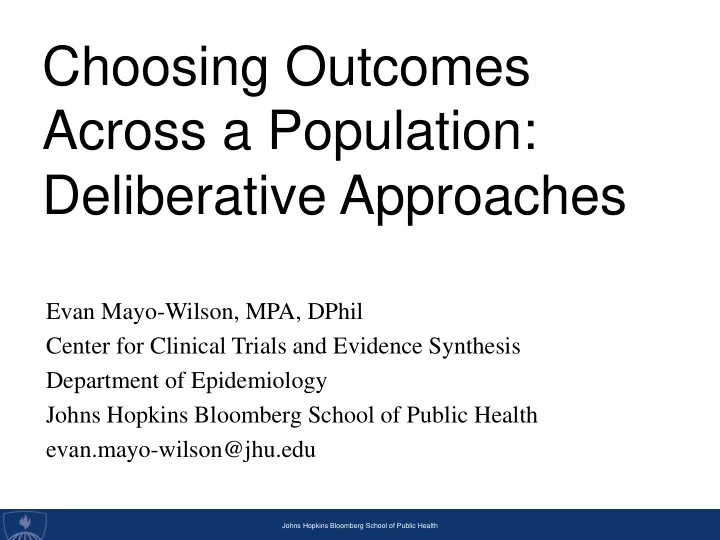

Choosing Outcomes Across a Population: Deliberative Approaches Evan Mayo-Wilson, MPA, DPhil Center for Clinical Trials and Evidence Synthesis Department of Epidemiology Johns Hopkins Bloomberg School of Public Health evan.mayo-wilson@jhu.edu Johns Hopkins Bloomberg School of Public Health
Conflict of interest: None Funding: PCORI, JH-CERSI / FDA, ESRC (UK) Johns Hopkins Bloomberg School of Public Health
Core outcomes “minimum set of outcome measure that must be reported in all RCTs in a given health condition” (Boers, et al., 2014) Johns Hopkins Bloomberg School of Public Health
Why core outcomes? Enable decisions based on most important outcomes (& measures) Prevent bias Facilitate comparison & synthesis Reduce waste Johns Hopkins Bloomberg School of Public Health
How to identify outcomes? Include patient advisors Traditional qualitative research (e.g., focus groups) Stated preference methods Consensus process (Delphi, nominal group technique, deliberative methods) Johns Hopkins Bloomberg School of Public Health
Patient reported outcomes Direct assessment of patient experience PROs may be important to patients Important outcomes can also be observed Some patients cannot report outcomes Johns Hopkins Bloomberg School of Public Health
Patient selected outcomes Patients may identify what matters But not aware of all possible outcomes (especially new products) Medical terms vs. describing experience Glucose > 120 mg/dl Increased prolactin levels Prolongation of the QT interval Extrapyramidal symptoms Values may differ Johns Hopkins Bloomberg School of Public Health
Patients make a difference For example, the original OMERACT core set in rheumatoid arthritis was established without direct patient input; but focus groups were held at OMERACT 6 (in 2002), the first OMERACT meeting that patients were invited to attend. Supported by a previous email survey, fatigue and sleep were identified as missing from the OMERACT core set, which only included pain, function, joint counts, global assessments and a blood test. The experience of fatigue has been reported by a large proportion of people with rheumatoid arthritis, and it is often the most important problem for individual patients. (Williamson, et al., 2012) Johns Hopkins Bloomberg School of Public Health
Addressing diversity Vision not meeting requirement for driving Cataracts Relatively more important to: 1) Whites 2) People with high SES Glaucoma Needing eye surgery (for cataracts or high eye pressure) Needing medicine for controlling high blood pressure or cholesterol Infection (e.g., sinusitis) Yu T, Holbrook JT, Thorne JE, Flynn TN, Van Natta ML, Puhan MA (2015). ”Outcome preferences in patients with noninfectious uveitis: Results of a Best-Worst Scaling Study." Invest Ophthalmol Vis Sci 56: 6864-6872. Johns Hopkins Bloomberg School of Public Health
www.comet-initiative.org Johns Hopkins Bloomberg School of Public Health
Delphi consensus method Asynchronous and anonymous Round 1: Topic generation Large or small groups Round 2: Combines quantitative and Assessment qualitative data Round 3: Patients can propose outcomes Feedback / Discussion Iterative Round 4: Reassessment Johns Hopkins Bloomberg School of Public Health
Importance (n = 20) Your response Group median Helpfulness (n = 20) Ease of implementation (n = 20) Number of panelists who answered this question Hover over to see Timing of Implementation (n = 20) the response scale ExpertLens Software, RAND Corp Thanks to Dmitry Khodyakov and Sean Grant Johns Hopkins Bloomberg School of Public Health
Delphi with multiple groups Group 2 Group 3 Group 1 Assessment Assessment Assessment Feedback / Discussion Feedback / Discussion Feedback / Discussion Reassessment Reassessment Reassessment Feedback / Discussion Reassessment Johns Hopkins Bloomberg School of Public Health
Conclusions Identify important outcomes Explore areas consensus & disagreement Compare within and between groups Identify hypotheses for confirmatory research Johns Hopkins Bloomberg School of Public Health
Recommend
More recommend